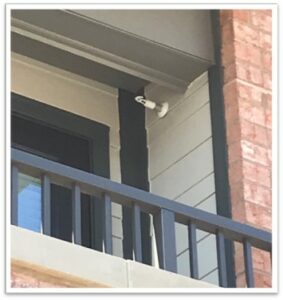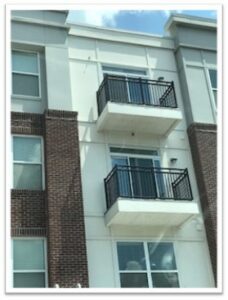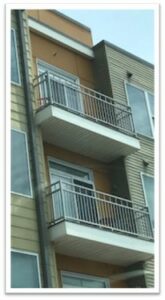Balcony Sprinkler Requirements: NFPA 13R and the International Building Code

Balcony Sprinkler Requirements: NFPA 13R and the International Building Code
By John Swanson, Codes & Standards Specialist – NFSA
Fire safety is paramount in building design and construction. Exterior balconies, while aesthetically pleasing and functional, can pose fire safety challenges. Statistics show the number of fires starting on balconies and decks has grown significantly over the past few years. The primary causes being smoking and barbecue grills.
The National Fire Protection Association (NFPA) and the International Building Code (IBC) are two documents that provide requirements for fire protection systems in buildings. In this blog, we will delve into the specific regulations of NFPA 13R and the IBC concerning fire sprinklers protecting exterior balconies.

What Does NFPA 13R Say About Balcony Sprinkler Requirements?
NFPA 13R, titled “Standard for the Installation of Sprinkler Systems in Low-Rise Residential Occupancies,” provides comprehensive guidance on the installation of fire sprinkler systems in low-rise residential buildings. Section 1.1 in NFPA 13R defines “low rise” as, “up to and including four stories in height in buildings not exceeding 60 feet in height above grade plane”.
These buildings typically include apartment complexes, condominiums, hotels, motels, and other multi-family dwellings. While NFPA 13R primarily focuses on residential occupancies, it does contain specific requirements related to fire sprinklers on exterior balconies.
Section 6.6.5.1 of the 2022 edition of NFPA 13R states:
“Where a roof, deck, or balcony greater than 4 ft wide is provided above, sprinklers shall be installed to protect attached balconies, attached exterior decks, and ground floor patios directly serving dwelling units in Type V construction”.
This provision mandates the installation of fire sprinklers under exterior balconies when those balconies are connected to a building of Type V construction and the roof or deck above must extend out from the building more than 4 feet. It’s also important to clarify that this requirement only applies to balconies serving dwelling units.
A similar requirement was added to the 2022 edition of NFPA 13 (Section 9.3.20). The purpose of this requirement is to address the potential fire hazards associated with fires on balconies extending upward to the attic. Remember, in many cases, the attic in buildings protected with a sprinkler system designed to NFPA 13R are not protected with sprinklers. Fires spreading to an unsprinklered attic may pose challenges for fire departments.

International Building Code (IBC) and Fire Sprinklers
The International Building Code (IBC) is the most widely used model building code adopted in the United States. It provides regulations for building design and construction to ensure safety, which includes fire protection. The IBC often references NFPA standards in its requirements, and its guidance on fire sprinklers under exterior balconies differ from NFPA 13R.
Section 903.3.1.2.1 of the 2021 IBC states:
Sprinkler protection shall be provided for exterior balconies, decks, and ground floor patios of dwelling units and sleeping units where either of the following conditions exist.
- The building is of Type V construction, provided there is a roof or deck above.
- Exterior balconies, decks, and ground floor patios of dwelling units and sleeping units are constructed in accordance with Section 705.2.3.1, Exception #3.
Exception #3 to Section 705.2.3.1 requires the exterior balcony or deck to be fire rated or protected by sprinklers.

Conclusion
Fire sprinkler systems are a critical component of fire safety in buildings, and their proper installation under exterior balconies is an important consideration to mitigate fire risks associated with fires starting on the balcony.
Both NFPA 13R and the IBC require fire sprinklers on balconies and decks when certain conditions are met. Adhering to these requirements ensures that the occupants of multi-family residential buildings are adequately protected in the event of a fire, contributing to overall fire safety in the built environment.
Further Reading
Use Residential Sprinklers for Balconies?
Is a Sprinkler Required for an NFPA 13R Balcony?
HAVE A QUESTION ABOUT FIRE PROTECTION FOR BALCONIES? CONTACT THE NFSA TODAY
Members and employees of NFSA work very closely in the codes and standards development process. Our team of experts stay on the cutting edge of fire protection issues by participating in over 250 codes and standards development committees. If you have an interest in NFSA’s mission to protect lives and property through the widespread acceptance of the fire sprinkler concept, or you simply want to get more involved in the codes and standards process with NFSA, please visit our membership page.
More about the author
John Swanson currently serves as NFSA’s Codes and Standards Specialist. In this role he provides training and education and represents NFSA on codes and standards technical committees. He currently serves as a Principal member of the NFPA 72 – National Fire Alarm and Signaling Code Technical Committee and is a past member of the International Building Code (IBC) Fire Safety Committee and International Fire Code (IFC) Interpretation Committee.
From 2013-2017, John served as a fire service representative appointed by Minnesota Governor, Mark Dayton to the Minnesota Board of Architecture and Engineering.
